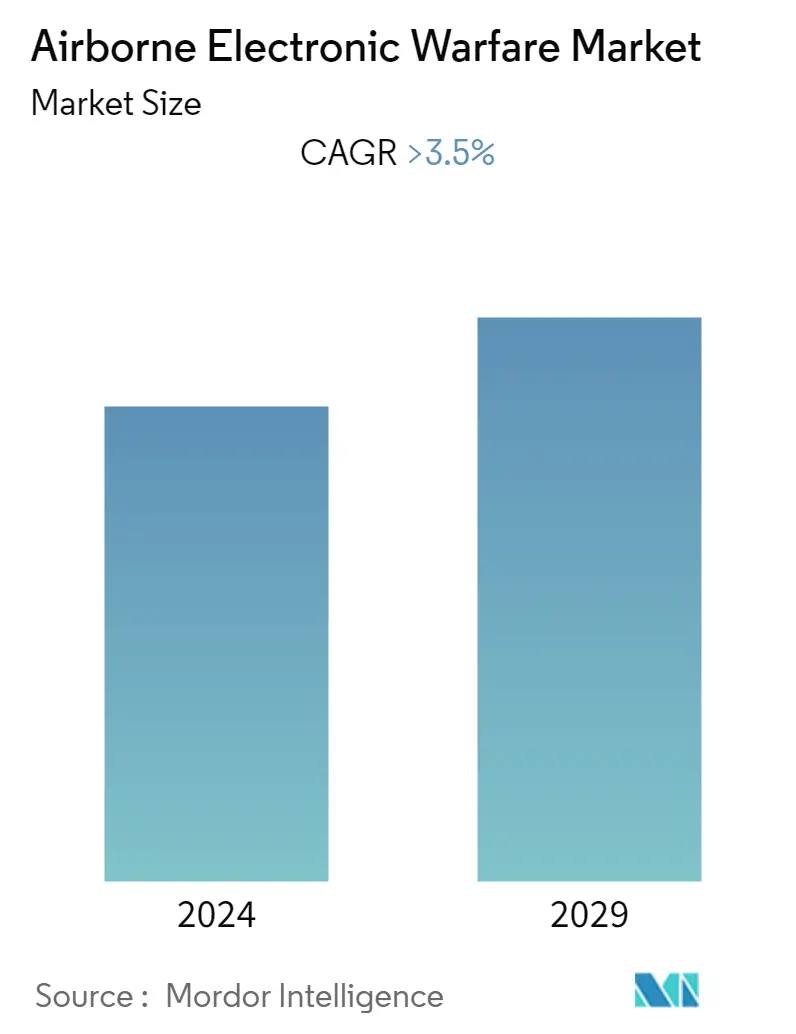Market Size of Airborne Electronic Warfare Industry

| Study Period | 2019 - 2029 |
| Base Year For Estimation | 2023 |
| CAGR | > 3.50 % |
| Fastest Growing Market | Asia Pacific |
| Largest Market | North America |
| Market Concentration | Medium |
Major Players.webp)
*Disclaimer: Major Players sorted in no particular order |
Airborne Electronic Warfare Market Analysis
The airborne electronic warfare market is anticipated to register a CAGR of more than 3.5% during the forecast period.
- Despite the impact of the COVID-19 pandemic on the global economy, the military expenditure of several countries remained constant, if not higher, than in previous years. Global military expenditure was USD 1.98 trillion in 2020 and was increased by 0.7% to USD 2.1 trillion in 2021.
- The supply chain disruption caused by the pandemic had a slightly negative impact on the airborne electronic warfare market. This disruption caused mild disruptions to the ongoing activities of product innovation and manufacturing for a brief period in 2020. However, as the market has recovered from the pandemic, the airborne electronic warfare (EW) market has gained a stable position in the market.
- The increasing demand for intelligence, surveillance, and reconnaissance (ISR) systems from various armed forces around the world is anticipated to drive the growth of the airborne electronic warfare market over the coming years.
- Furthermore, the advancements in technology in the areas of enhanced stealth capabilities of aircraft, communication jamming technology, and advanced air defense systems are generating demand for air electronic protection and support measures in combat and non-combat aircraft.
Airborne Electronic Warfare Industry Segmentation
Electronic warfare (EW) is any action involving the use of the electromagnetic spectrum (EM spectrum) or directed energy to control the spectrum, attack an enemy, or impede enemy assaults.
The airborne electronic warfare market has been segmented by capability, type, and geography. By capability, the market is segmented into electronic attack, electronic protection, and electronic support. By type, the market is segmented into manned aircraft and unmanned aircraft. By geography, the market is segmented into North America, Europe, Asia-Pacific, Latin America, and Middle East and Africa.
The report offers market size and forecasts for all the above segments in terms of value in USD billion.
| Capability | |
| Electronic Attack | |
| Electronic Protection | |
| Electronic Support |
| Type | |
| Manned Aircraft | |
| Unmanned Aircraft |
| Geography | |||||||
| |||||||
| |||||||
| |||||||
| |||||||
|
Airborne Electronic Warfare Market Size Summary
The airborne electronic warfare market is poised for steady growth, driven by the increasing demand for advanced intelligence, surveillance, and reconnaissance systems. Despite the challenges posed by the COVID-19 pandemic, which caused temporary supply chain disruptions, the market has stabilized and is expected to expand due to technological advancements in stealth capabilities, communication jamming, and air defense systems. Unmanned aerial vehicles (UAVs) have become pivotal in ISR missions, with manufacturers focusing on enhancing stealth and electronic countermeasures to evade radar and integrated air defense systems. The introduction of new UAV models with electronic warfare capabilities is anticipated to further propel the market, as global defense forces rapidly induct these platforms into active service.
The presence of major military aircraft manufacturers in the United States, such as Boeing, Northrop Grumman, and Lockheed Martin, has significantly contributed to the research and development of airborne electronic warfare systems. The United States remains the largest market for these systems, with ongoing initiatives to upgrade and procure advanced electronic warfare aircraft. Prominent industry players, including Lockheed Martin, Raytheon Technologies, and BAE Systems, are actively involved in developing modular and advanced electronic warfare solutions. These solutions aim to enhance threat identification and countermeasure capabilities for current-generation platforms. Recent developments, such as BAE Systems' Storm electronic warfare modules and Lockheed Martin's ASQ-239 hardware for the F-35, underscore the industry's commitment to providing state-of-the-art electronic warfare capabilities for modern combat scenarios.
Airborne Electronic Warfare Market Size - Table of Contents
-
1. MARKET DYNAMICS
-
1.1 Market Overview
-
1.2 Market Drivers
-
1.3 Market Restraints
-
1.4 Porter's Five Forces Analysis
-
1.4.1 Bargaining Power of Buyers/Consumers
-
1.4.2 Bargaining Power of Suppliers
-
1.4.3 Threat of New Entrants
-
1.4.4 Threat of Substitute Products
-
1.4.5 Intensity of Competitive Rivalry
-
-
-
2. MARKET SEGMENTATION
-
2.1 Capability
-
2.1.1 Electronic Attack
-
2.1.2 Electronic Protection
-
2.1.3 Electronic Support
-
-
2.2 Type
-
2.2.1 Manned Aircraft
-
2.2.2 Unmanned Aircraft
-
-
2.3 Geography
-
2.3.1 North America
-
2.3.1.1 United States
-
2.3.1.2 Canada
-
-
2.3.2 Europe
-
2.3.2.1 United Kingdom
-
2.3.2.2 Germany
-
2.3.2.3 France
-
2.3.2.4 Russia
-
2.3.2.5 Rest of Europe
-
-
2.3.3 Asia-Pacific
-
2.3.3.1 China
-
2.3.3.2 Japan
-
2.3.3.3 India
-
2.3.3.4 South Korea
-
2.3.3.5 Rest of Asia-Pacific
-
-
2.3.4 Latin America
-
2.3.4.1 Mexico
-
2.3.4.2 Brazil
-
2.3.4.3 Rest of Latin America
-
-
2.3.5 Middle East and Africa
-
2.3.5.1 Saudi Arabia
-
2.3.5.2 United Arab Emirates
-
2.3.5.3 Israel
-
2.3.5.4 Rest of Middle East and Africa
-
-
-
Airborne Electronic Warfare Market Size FAQs
What is the current Airborne Electronic Warfare Market size?
The Airborne Electronic Warfare Market is projected to register a CAGR of greater than 3.5% during the forecast period (2024-2029)
Who are the key players in Airborne Electronic Warfare Market?
Lockheed Martin Corporation, Northrop Grumman Corporation, Saab AB, BAE Systems plc and Raytheon Technologies Corporation are the major companies operating in the Airborne Electronic Warfare Market.

